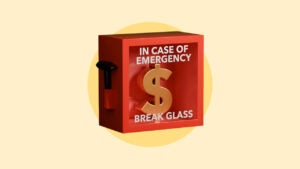Everything you need to know about emergency loans

Key takeaways
- Emergency loans are borrowed for unexpected expenses when you don’t have enough savings.
- There are different types of emergency loans, including installment and revolving options.
- Personal loans and personal lines of credit offer lower interest rates and more flexibility, while payday loans and title loans have higher interest rates and should be used as a last resort.
- Emergency loans can help cover a wide range of expenses, including medical bills and home or car repairs.
An emergency loan is any money borrowed for an unexpected expense. People often turn to them because they don’t have enough savings to pay cash for bills related to an emergency. Bankrate’s Emergency Savings Report found more than a third of U.S. adults (35 percent) would borrow money to pay for an emergency expense of $1,000 or more.
There are a variety of different emergency loans to choose from, including credit cards, personal loans, payday loans and personal lines of credit. Each has its own benefits and drawbacks worth knowing before you start applying for them.
What to know about emergency loans
If you need cash immediately, you have several types of emergency loans to choose from. Which product is right for you depends on how much you need, how fast you need the money, your financial situation and your monthly budget.
Emergency loans can be installment or revolving forms of credit. With an installment loan, you receive all the funds at once and make fixed monthly payments over a set period. With a revolving loan, you can use, pay off and reuse the credit as often as needed.
Both options can be funded quickly, with funds sometimes available the same day you apply.
Emergency loans: Installment options
If you want a predictable payment and fixed interest rate and need all the funds upfront, these installment loan options are worth considering.
Personal loans
Personal loans are often a go-to choice in an emergency because they can be funded quickly — sometimes the same day you apply — with a relatively easy approval process. Emergency personal loans interest rates are typically fixed with payments that can be spread out over one to seven years, giving you more payment choices to fit your budget.
Most emergency personal loans are unsecured, which means you qualify based on your credit score, income and job history. You may qualify for loan amounts between $1,000 and $50,000 and for a rate below 8 percent if you have excellent credit. However, bad credit personal loan lenders may approve borrowers with scores as low as 300, but the rates can be as high as 36 percent.
Payday loans
Payday loans are small emergency loans tied to your regular paycheck. They offer a fast cash option if you need up to $250. They must be repaid, plus fees, by your next paycheck and annual percentage rates (APRs) can exceed 400 percent. Because they are approved based entirely on your paycheck, and your credit is not often checked.
Many states consider payday loans predatory and regulate them heavily, and they should only be used as a last resort. Fixing a car you use for work, paying a past due utility bill or for a medical prescription for you or a sick family member are situations where a payday loan might be necessary.
Title loans
A title loan is a secured installment loan option worth considering if you own a car with no loan on it. These emergency cash loans typically allow you to borrow 25 to 50 percent of your car’s value with repayment terms of 15 to 30 days.
Title loans may be easier to qualify for at lower rates than payday loans, but your vehicle must meet the lender’s standards. However, if you can’t repay the loan, the bank could repossess your vehicle.
Emergency loans: Revolving options
Credit cards and other types of revolving credit come in handy if you can’t afford an installment loan payment, or don’t need all the emergency cash immediately. Your payment is only based on the amount you use, giving you a lower payment if you only need to borrow a small amount of your full credit line.
Borrowers should note the ways revolving credit can affect credit scores and habits. Maxing out your credit line can lower your credit score because it affects your credit utilization ratio. The more available credit you use, the lower your credit score will be. It can also be easy to get into the habit of carrying a balance if you only make the minimum payment every month.
By comparison, installment loans don’t affect your credit utilization ratio and require you to pay the loan off in a set time period.
Credit cards
Using an existing credit card if you need emergency money is a relatively hassle-free option. You can also request a cash advance, although you’ll usually pay a higher rate and a transaction fee between 3 and 5 percent for the advance. You’ll only make payments on the amount you use, and minimum payments are usually much lower than what you pay for a personal loan. However, credit card rates are typically variable and may be significantly higher than personal loan rates.
Personal line of credit
A personal line of credit gives you the same flexibility as a credit card, but at rates that are often lower than credit cards. Payments are based on how much you borrow and the line can be paid in full and re-used. You’re typically capped at borrowing $20,000, which is much less than the $50,000 average you’ll find with personal loans.
However, they can be a good option for ongoing expenses like multiple home repairs and major dental work.
How to choose the right emergency loan
You may not have time to research different loan options if you need emergency cash immediately. The stress of a broken down car, a large deductible due at urgent care or a pending utility shut-off notice may be more top of mind, making it important to be able to compare your options quickly.
Use this table for a quick glance at the major benefits of each type of loan.
| Emergency loan type | May be a good choice if |
|---|---|
| Installment | |
| Personal loan |
|
| Title loan |
|
| Payday loan |
|
| Revolving | |
| Credit card |
|
| Personal line of credit |
|
What emergency loans can be used for
The most common uses for emergency loans include medical bills and repairs, but they can be used to cover almost any expense.
- Medical bills: If you or a loved one has to go to the emergency room, for example, and your insurance policy doesn’t cover the trip in full, an emergency loan can cover the out-of-pocket costs.
- Car repairs: No matter what type of car you drive or how new it is, there’s a chance it will require a repair at some point in time. Unexpected car repair costs can be as low as $20 to fix a flat tire to $6,000 to repair an overheating engine. You also have to consider transportation arrangements if the car repair takes several days or even weeks.
- Home repairs: A leaky faucet, a running toilet, a broken furnace and cracked siding are all examples of issues you may face as a homeowner. Fortunately, an emergency loan can help you keep your home in optimal shape when systems break down. The cost of home repairs varies greatly, but HomeAdvisor estimates that they range from about $4,000 to $26,000.
- Everyday bills: If you lose your job, get your hours cut or are unable to work for any reason, you may need to take out an emergency loan to pay for your mortgage or rent, utilities, groceries and other bills. While monthly bills depend on a number of factors, including your family size and location, the average American family spends $72,967 per year on total household expenditures.
Bottom line
Some emergency loans are healthier for your finances than others. Even when you need money quickly, take time to look at your options so you can get the funds you need without hurting your financial health in the long run.
You may also like

How to get a $40,000 personal loan

$15,000 personal loans: Everything you need to know

How to get an emergency loan in 5 simple steps




